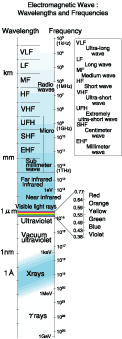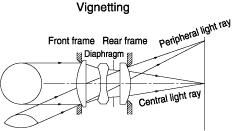 |
According to the dictionary, Light is
defined variously as: 1. something that makes things
visible or affords illumination; an illuminating agent
or source, as the sun, a lamp, or a beacon: 2.
electromagnetic radiation to which the organs of sight
react, ranging in wavelength from about 4000 to 7700
angstrom units and is propagated at a speed of about
186,300 miles per second, and including a similar form
of radiant energy that does not affect the retina, as
ultraviolet or infrared rays; 3. a gleam or sparkle, as
in the eyes; 4. a particular light or illumination in
which an object seen takes on a certain appearance; 5. a
person who is an illuminating or shining example;
luminary; 6. mental or spiritual illumination or
enlightenment; 7. the aspect in which a thing appears or
is regarded. The definition most indispensable to the
understanding of light as used in photography is 2
above. Types of electromagnetic radiation vary according
to wavelength. Starting from the shortest wavelengths,
electromagnetic radiation can be classified into
(special form enter) rays, X rays, ultraviolet light
rays, visible light rays, infrared light rays,
far-infrared light rays, microwave radiation, ultrashort
wave radiation (VHF), short-wave radiation, medium wave
radiation (MF) and long wave radiation. In photography,
the most utilized wavelengths are in the visible light
region (400nm-700nm). Since light is a type of
electromagnetic radiation, it can be thought of as a
type of wave in the category of “light waves.” A light
wave can be regarded as an electromagnetic wave in which
an electric field and magnetic field vibrate at right
angles to each other in a plane perpendicular to the
direction of propagation. The two elements of a light
wave which can actually be detected by the human eye are
the wavelength and amplitude. Differences in wavelength
are sensed as differences in color (within the visible
light range) and differences in amplitude are sensed as
differences in brightness (light intensity). The third
element which cannot be detected by the human eye is the
direction of vibration within the plane perpendicular to
the light wave’s direction of propagation. |
|
A single standard zoom lens does the
work of several lenses with fixed focal length. Take
advantage of the lens’ speedy operation to capture the
full breadth of a scene with a wide-angle setting, or
zoom in instantly to shoot a close-up of some
particularly attractive highlight in telephoto mode.
Telephoto zoom lenses bring an added dimension to EOS
system performance. Follow moving subjects such as
athletes or animals in action, and experience the
telephoto lens’ characteristic shallow depth of field
and “compressed” effect as you enjoy this added
dimension of expressive power. |
![]()


